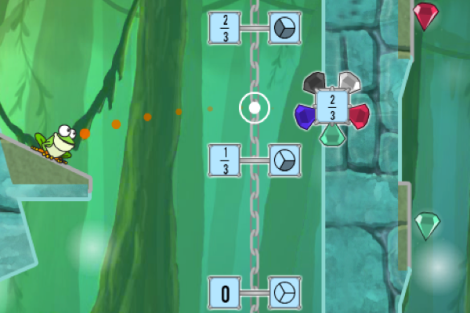
How Kids Play Games: Teachable Moments in Refraction and Treefrog Treasure
Posted by cemignano on
Guest blogger Eleanor O’Rourke of the University of Washington shares her reflections on a study of how children and adults play two of GameUp’s games, Refraction and Treefrog Treasure.
Adults and children play games differently. While this may not be surprising, learning about the differences in their play can help designers create better educational games and help teachers use games effectively in the classroom. As part of a project at the Center for Game Science, my collaborators and I studied how children and adults play two GameUp games developed by the Center, Refraction and Treefrog Treasure. We found many behavioral differences that highlight a wide variety of teachable moments in these two games.
Refraction and Treefrog Treasure were both designed to teach fractions. Treefrog Treasure teaches numberline concepts, while Refraction focuses on how to create and add fractional values. Refraction requires more strategy and problem solving than Treefrog Treasure, but both games require some planning ahead.
To compare how children and adults play these two games, we looked at the behavior of two different online populations. We collected anonymized gameplay data from BrainPOP’s GameUp, which attracts primarily children, and from Kongregate, a free flash game website that targets adults. We analyzed the moves that players make in these games to see whether Kongregate players (adults) displayed different behavior than BrainPOP players (children).
We found that the two populations play Refraction and Treefrog Treasure very differently. BrainPOP players make more mathematical mistakes in both games that Kongregate players, choosing incorrect numberline values more often in Treefrog Treasure and creating incorrect fractional values more often in Refraction. BrainPOP players also are less strategic than Kongregate players. It took them longer to jump through tricky sections of Treefrog Treasure, and they repeated moves and reached dead ends more often in Refraction puzzles. While we would expect children to have more trouble with fraction concepts and strategic thinking than adults, understanding how children approach these types of problems is valuable.
The areas where children struggle in Refraction and Treefrog Treasure highlight teachable moments. Our findings show that these games are great platforms for teaching strategy and problem solving, in addition to teaching fraction concepts! In Refraction, children struggled with strategic thinking, and often made moves that made it impossible to solve the puzzle. Educators could use this as an opportunity to teach students how to break Refraction levels into subproblems and work methodically. In Treefrog Treasure, children had trouble jumping through tricky parts of the levels. This provides an opportunity to teach about thinking ahead and planning. One of the great benefits of games as educational tools is the wide diversity of skills that players use to solve puzzles and beat levels, providing many different opportunities for learning!
Read the full paper, published at the Foundations of Digital Games conference, to learn more! Also, check out the Center for Game Science and play Refraction and Treefrog Treasure on GameUp!














